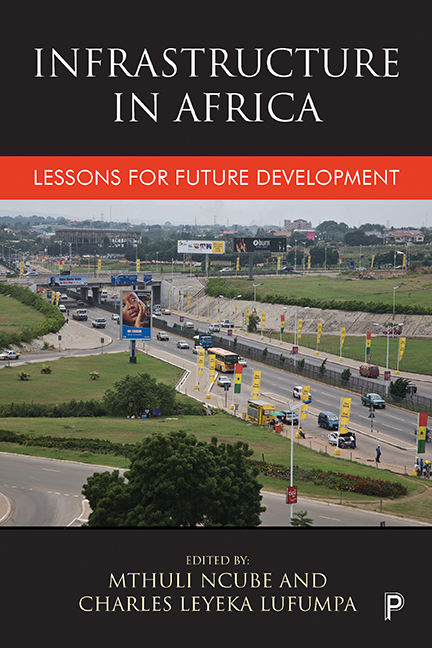Book contents
- Frontmatter
- Contents
- List of figures
- List of tables
- List of boxes
- Notes on contributors
- Acknowledgements
- Foreword
- Introduction: Infrastructure in African development
- Part 1 Spatial and demographic contexts
- Part 2 Sector-specific issues
- Part 3 Regional issues
- Part 4 Financing issues
- Part 5 Concluding remarks
- Index
four - Infrastructure and rural productivity in Africa
Published online by Cambridge University Press: 05 April 2022
- Frontmatter
- Contents
- List of figures
- List of tables
- List of boxes
- Notes on contributors
- Acknowledgements
- Foreword
- Introduction: Infrastructure in African development
- Part 1 Spatial and demographic contexts
- Part 2 Sector-specific issues
- Part 3 Regional issues
- Part 4 Financing issues
- Part 5 Concluding remarks
- Index
Summary
Introduction
Rural activities remain highly relevant to the overall development process of Sub-Saharan Africa. The African population is mainly located in rural areas, ranging from 53% to 78% of the population in the Economic Community of Central African States (ECCAS) and the East African Community (EAC) respectively. Almost two-thirds of the labor force is engaged in agricultural-related activities and agriculture makes up a very significant share of gross domestic product (GDP) in all sub-regions, ranging from 13% to 32% in the Southern African Development Community (SADC) and the Economic Community of West African States (ECOWAS) respectively. The intersection of these two processes—high rural population and high agricultural activity—results in agriculture being the main source of income for 90% of the rural population in Africa (ECA, 2005).
The rural population faces extreme poverty and lack of access to services. Studies indicate that more than 1 billion people in the world live in extreme poverty, of which 415 million reside in Sub-Saharan Africa. In 2011, more than 900 million people lived in Sub-Saharan countries; 47% of them on less than US$1.25 a day and 64% in rural areas (World Bank, 2015). It is estimated that between 75% and 80% of the poor live in rural communities (IFAD, 2011). In household services, urban coverage rates are five to 10 times higher than those in rural areas (AfDB, 2011). Electricity and improved water supply such as piped connections or stand-posts extend to the majority of the urban population, but to less than one-fifth of the rural population with minimal differences across the sub-regions. Rural access to information and communications technology (ICT) services remains negligible (AfDB, 2011).
A vicious circle characterizes the relationship between agriculture and rural poverty. A high reliance on agriculture is not responsible for rural poverty; however, in order to fight poverty improving agricultural productivity is essential. Low productivity and poverty feed each other creating a vicious circle; this situation is known as the “Sahel-Syndrome”. More accurately, this is a mechanism that forces poor peasants back to agricultural marginal lands for non-capital intensive exploitation.
Intensifying agricultural activities on marginal sites increases environmental degradation and damages the natural production basis, thus decreasing yields which leads to further impoverishment and stimulates an extension of the syndrome by expanding the agricultural frontier even further (Roehrig and Menz, 2005).
- Type
- Chapter
- Information
- Infrastructure in AfricaLessons for Future Development, pp. 137 - 152Publisher: Bristol University PressPrint publication year: 2017
- 1
- Cited by



